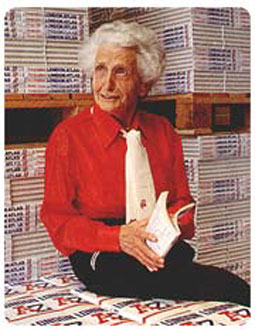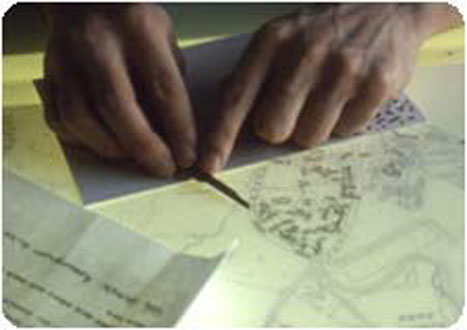PHYLLIS PEARSALL 
Map Designer (1906-1996)
Working eighteen hours a day to walk 3,000 miles of London’s streets, the artist PHYLLIS PEARSALL (1906-1996) not only conceived, designed and produced the A-Z street atlas of London, but founded her own company to publish it. The A-Z remains one of the most ingenious examples of early 20th century information design.
Realising that she did not know the location of the party to which she was invited in the London district of Belgravia one evening in 1935, Phyllis Pearsall armed herself with the most recently published London street map she could find. It was the 1919 Ordnance Survey map and, hard though she tried, Pearsall could not find the address of the party.
Pearsall decided to devise a more efficient means of helping other people to navigate the labyrinthine London streets. Working from her bedsit on Horseferry Road near Victoria Station, she set off early each morning to walk – and catalogue – the streets of the city. As London was so big, rather than produce a cumbersome map, which would be very hard to read as each street, bridge or building would be so small in scale, Pearsall decided to divide it into different sections, each of which would be coded in an index.
Working for up to eighteen hours a day, she walked a total of 3,000 miles while mapping London’s 23,000 streets. When she failed to persuade any of the established book publishers to accept her atlas, Pearsall published it herself by founding the Geographers’ Map Company. The A-Z Atlas and Guide to London and Suburbs was published in 1936 and has remained the principal guide to the city ever since. A tribute to Phyllis Pearsall’s vision and determination, the A-Z is an exemplar of modern information design. Yet Pearsall never saw herself as a designer, but as an artist and travel writer who happened to have invented a successful design concept by chance.
Born Phyllis Gross in Dulwich, south east London in 1906, she was the daughter of Alexander Gross (originally Grosz), a Hungarian-born map maker and his Irish-Italian artist wife, Isabella Crowley. Phyllis was educated at Roedean, an expensive girl’s boarding school, but taken away at the age of 14 when her father’s business folded and he was declared bankrupt. He fled to the US leaving Phyllis with her mother whose lover, Alfred Orr, the royal portrait painter, refused to allow her to live with them. She fled to France. At one point she was so hard up that she slept on the street, but then scraped a living by teaching English, writing for an ex-pat newspaper in Paris and painting portraits. She also attended philosophy classes at the Sorbonne.
In 1926 she returned to London where she met and later married the artist Richard Pearsall, a friend of her brother Anthony. The newly married couple travelled around Europe together for several years but separated in 1935 and she moved back to London. Pearsall began work on the A-Z helped only by the draughtsman James Duncan, who had once worked for her father. She rose at 5am each day to walk the streets in order to compile the atlas and index. “I had to get my information by walking,” she later recalled. “I would go down one street, find three more and have no idea where I was.”
Once they were drawn, the maps needed numerous checks for spelling mistakes, inaccuracies or omissions, as did the index. Towards the end of the process Pearsall realised that they had left out Trafalgar Square. She chose the name of the atlas – inspired by its all-important index – and chose an Eric Gill typeface for the visual identity of the title.
When the A-Z was rejected by all the established book publishers, Pearsall was encouraged by her father to set up her own business, the Geographers’ Map Company. She arranged for 10,000 copies of the atlas to be printed, completing the design and proof-reading herself. The printer used the wrong presses and there were numerous inaccuracies in the index. Nonetheless Pearsall managed to persuade the W.H. Smith chain of newsagents to stock 250 copies in its London shops, and delivered them there herself in a wheelbarrow. W.H. Smith sold out and other retailers started to place orders. Even so Pearsall could still only afford to employ a single draughtsman to help her to run the Geographer’s Map Company and continued to handle the indexing, printing, sales, delivery and book-keeping herself.
During World War II, the company’s activities were curtailed by official restrictions on map production, even though sales of the original A-Z were bolstered by the influx of US and Commonwealth troops flooding into London. Pearsall helped the war effort by working for the Home Intelligence Division of the Ministry of Information. After the war she returned to the Geographers’ Map Company and managed to overcome the shortage of paper in Britain by arranging for the atlases to be printed by letterpress in the Netherlands.
Pearsall was seriously injured in a plane crash when flying back from the Dutch printers in 1945 and her health was precarious for the rest of her life. Nonetheless, the company flourished under her leadership, as did her continuing careers in portraiture and writing. Despising bureaucracy, she instilled the Geographer’s Map Company with her independent spirit. Board meetings were banned and Pearsall, who placed great faith in spontaneous decision making, chose “On we go” as the company motto. Her objectives for the business were: “a commitment to natural and sustainable growth… in the hope of bringing together a work team that would appreciate and thrive (both in work and in their private lives) in an atmosphere of stability, mutual trust, honesty and high endeavour”.
In 1962 Pearsall moved the company’s headquarters from London to Sevenoaks in Kent, and launched new editions of the A-Z for cities such as Manchester, Liverpool, Birmingham, Edinburgh, Canterbury, Bath and Oxford. Three years later she transferred the ownership of the company to a charity, the Geographers’ Map Trust. Her intention was to ensure that her employees should “benefit from their contribution towards the company’s success” and “to create the most favourable circumstances for the long term survival of the founding ethics and ideals, instead of the A-Z team becoming subjugated by the inevitable threats of mergers and ‘the offer was too good to refuse’ takeovers.”
Having handed over her shares, Pearsall continued to work for the company, remaining as chairman and joint managing director until her death in 1996. The business continued to develop, notably by introducing compuer-aided design in 1990 to draw the maps. During the same year Phyllis Pearsall told the story of the A-Z’s design by publishing an autobiography entitled From Bedsitter to Household Name: The personal story of the first 50 years of the Geographers’ A-Z Map Company.
BIOGRAPHY
1906 Born Phyllis Gross in Dulwich, south east London, to the map maker Alexander Gross (originally Grosz) and his artist wife Isabella Crowley.
1920 Leaves Roedean School for Girls after her father is declared bankrupt. He moves to the US leaving her with her mother Isabella. Pearsall spends most of her late teens fending for herself in France, where she teaches, writes, paints and studies philosophy.
1926 Returns to England from France and meets Richard Pearsall, an artist friend of her brother Anthony.
1928 Marries Richard Pearsall and travels around Europe with him.
1935 Ends her relationship with Richard Pearsall to return to London where she tries to establish herself as a portrait painter and then starts work on the A-Z.
1936 After over a year of work the A-Z is completed. Pearsall fails to persuade a publisher to accept it and founds the Geographers’ Map Company to produce it herself.
1939 With the outbreak of World War II, Pearsall joins the war effort as a head of section in the Home Intelligence Division of the Ministry of Information.
1945 On a flight back from the A-Z’s Dutch printers Pearsall is seriously injured in a plane crash.
1962 Pearsall moves the company’s headquarters from Grays Inn Road in London to new premises in Sevenoaks, Kent.
1966 Founds the Geographers’ Map Trust by transferring ownership of the company to a charitable trust for the benefit of the employees.
1972 The insignia A-Z is added to the company’s name, the Geographers’ A-Z Map Company.
1986 Exhibition of Pearsall’s paintings at the Royal Geographical Society to commemorate the 50th anniversary of the Geographers’ A-Z Map Company.
1990 Publishes her autobiography From Bedsitter to Household Name: The personal story of the first 50 years of the Geographers’ A-Z Map Company.
1991 The company moves from Sevenoaks to larger premises in Borough Green, Kent.
Introduction of computers to the drawing process to produce maps.
1996 Phyllis Pearsall dies of cancer a few days before her 90th birthday.



